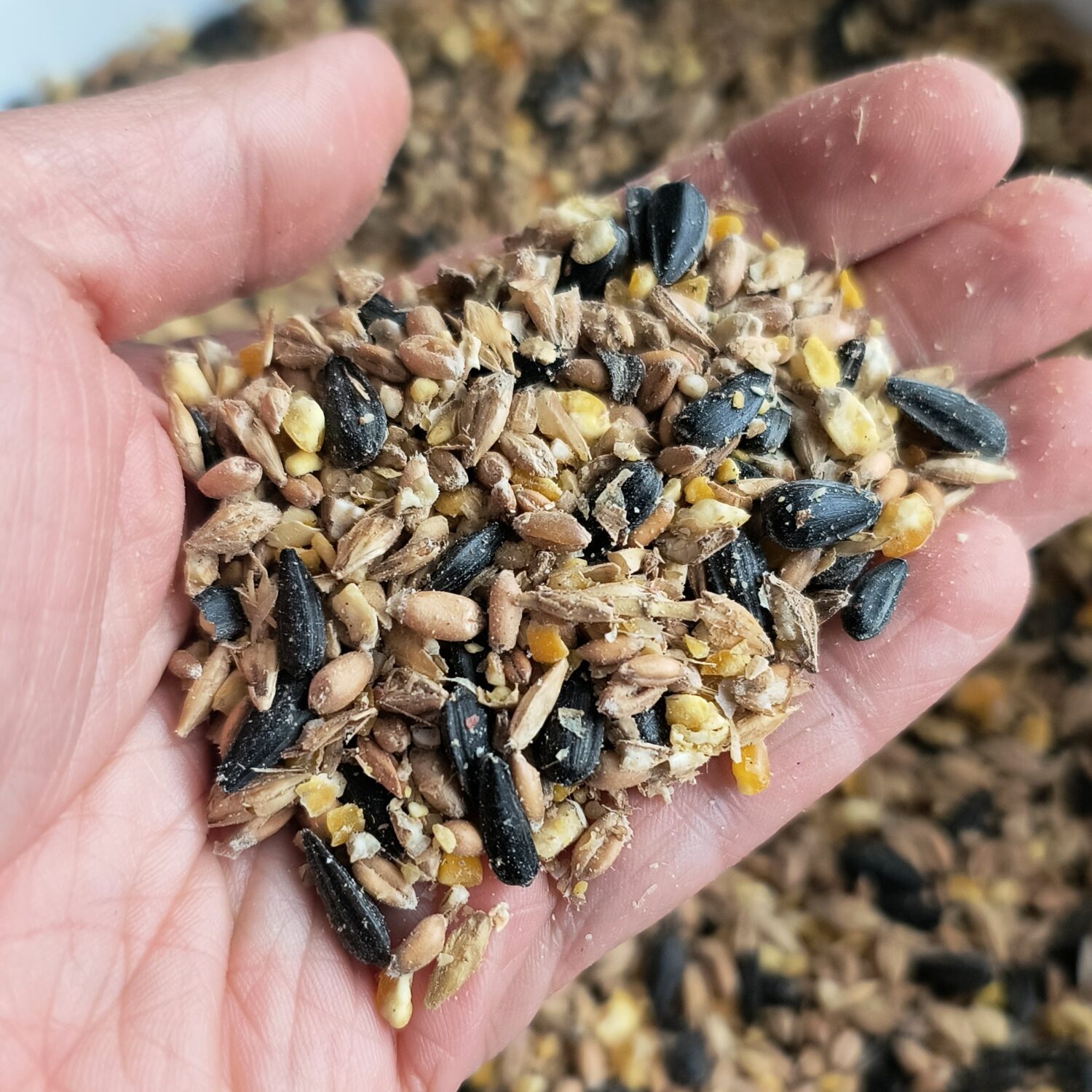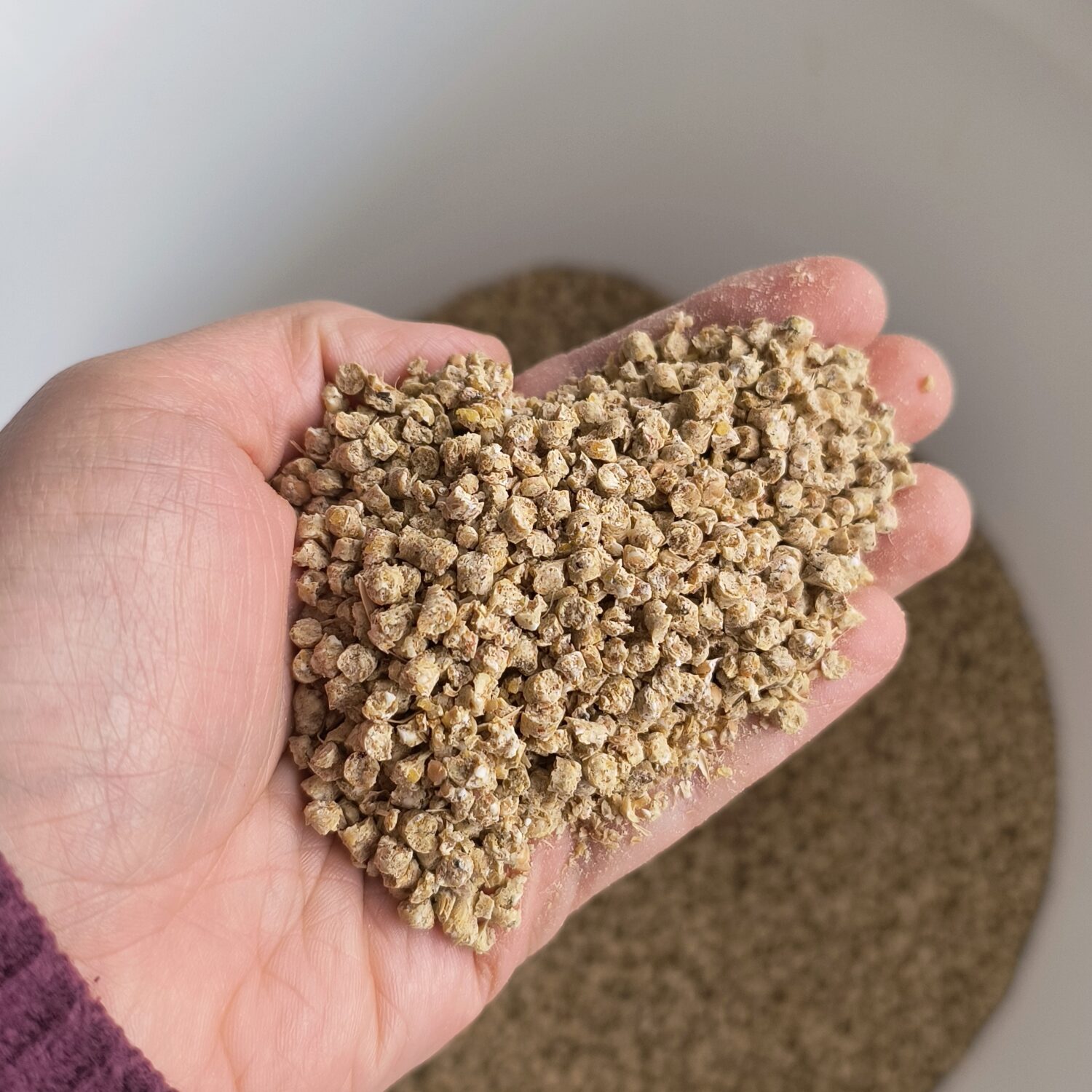What Do Our Chickens Eat?
I am often asked what I feed our chickens here at Westholme so I figured it was a good topic for FAQ Friday.
The feed you see in the image above makes up the bulk of our flock’s diet. It’s the Chicken Grower feed from Sollio and we buy it at Scotian Gold in Coldbrook, NS. We feed this to everyone 8 weeks of age or older. Chicks get un-medicated Chick Starter feed instead.
Wait, You Feed Grower Feed to Everyone?
Yes, we do! Since our flocks include roosters we need to consider their needs along with the needs of the hens. Layer feed is for hens that are laying eggs only. You aren’t supposed to feed it to any birds who are not laying eggs.
Layer feed generally contains about 4% calcium. A bird that is not laying only needs about 1% calcium in their feed. This means layer feed is a no-no for young pullets who are pre-lay, cockerels and roosters of any age, hens that are on break from laying eggs because they are molting or because the winter days are too short to stimulate laying, and also older hens who have stopped laying altogether due to age.
Feeding layer feed short term to pre-lay pullets or hens that are on break for a couple of months probably wouldn’t cause issues in the long run since they are going to be laying eggs in the near future BUT feeding layer feed to cockerels/roosters and older hens who never lay eggs is really bad for them.
Since senior hens and roosters don’t lay eggs, they don’t need the extra calcium that is added to layer feed. If a chicken isn’t laying eggs regularly to use up the calcium they’re getting from a layer feed, their kidneys have to do the work to get rid of the calcium instead. Over time this can cause kidney dysfunction and/or kidney failure. Kidney dysfunction/failure, in turn, can cause visceral gout and sometimes also articular gout. Gout causes uric acid deposits to form on/around organs (visceral gout) and within the joints (articular gout). These deposits can cause symptoms that range from lameness to death. You can learn more about both kinds of gout from folks that know more about it than me (and can explain it better) at PoutlryDVM.
A Little Note About Our Feed Choice
Feed options are rather limited and this grower feed comes as close to meeting the needs of everyone as we can get with our options. It’s too low in calcium for our actively laying hens but we supplement them to make up for it. It’s, unfortunately, a bit high in protein for the roosters when they aren’t breeding as well. There’s not much I can do about that though without diluting the feed to lower the protein to the detriment of the hens who need more protein than them.
There isn’t a chicken feed, to my knowledge, that has the 12% protein a fully grown rooster needs in maintenance (when they aren’t breeding). They all have quite a bit more than that. There aren’t enough people who keep roosters long term for feed companies to bother with a specific rooster formulation so the boys kind of have to make due. Most roosters end up as food at a young age and, the ones who don’t, are often fed layer pellets along with the hens they’ve been kept to protect.
Grower feed checks all the other boxes for the boys besides the protein content though. Actually, breeding roosters need a bit more protein than non-breeding ones so, during the hatching season, the grower feed will check all of the boxes for the boys. It’s just about ideal for them then, it’s just the off season that it’s a bit too high.
So How Do you Ensure The Hens That Are Laying Get Enough Calcium?
As I mentioned above, our actively laying hens are supplemented with oyster shell grit to provide them with the calcium they need to lay eggs. Each coop has a bowl of oyster shell grit available and the hens help themselves as needed. When they are molting or not laying eggs during the winter, they naturally stop consuming the oyster shell grit because they know they don’t require it at those times. The roosters, similarly, avoid eating the oyster shell except in the odd case where they eat a piece or two to encourage a hen to eat some.
Do You Feed Your Chickens Anything Else?
Each flock gets a small amount of scratch grains mixed with black oil sunflower seeds in the mornings. This is a treat for them so it’s not something I give them a lot of. I also use this mixture as a tool when he have a “hawk drill” and I need everyone back in their run under cover ASAP. I’ve trained them to run back to their safe, covered pens if I go out shaking the scratch jar and yelling “HAWK!”. Whether there is actually a hawk or not, they run their fluffy little butts back to their pens as fast as they can.
You can see the scratch (barley, wheat and cracked corn) and black oil sunflower seed mixture below.

When the weather is nice, the chickens naturally consume plants and insects in their pasture spaces. This time of year they don’t have that luxury, unfortunately.
In the gardening season, I devote a section of the garden to growing food specifically for the chickens. They love zucchini, winter squash, cucumbers, kale and tomatoes most so I always make sure to plant some for them. We have a large wild blueberry patch and tons of blackberries that they really enjoy eating. I also feed them all of the weeds from the gardens as well as some extra ones I pull from around the property. If we have any pest problems in the garden (ahem, potato beetles, I’m talking about you), I collect up the bugs and feed them to the chickens as well. They can eradicate a potato beetle infestation FAST so this is a win for everyone involved.
In the winter I have experimented with growing fodder (basically sprouting grains and growing grass indoors) for the birds but I experienced a lot of issues with mold last year and that resulted in a lot of it being thrown out instead of being fed to the chickens. I’ve got some new ideas for this winter and we’re going to give it a try again. In the winter I also feed them grocery store produce when I can get it on sale as well as our kitchen scraps (vegetable peelings/cut offs). I applied for the LOOP program in our area a couple of years ago but I am still on the wait list. The program diverts food that would have gone to the compost pile to farms to feed the animals instead. Hopefully someday we make it to the top of the list, the chickens would love some extra produce in the winter months especially.
When we have an excess of eggs that didn’t make the cut for sales and we aren’t able to eat them fast enough, I cook and feed the eggs back to the birds too. It might sound a bit weird but chickens really love eggs and they’re great for them nutritionally. Eggs are a baby chick’s first food, after all.
Do You Feed Organic?
As much as I would like to says yes, the truth is that we aren’t entirely organically fed. Anything I grow to feed them is organic because I use zero pesticides and only organic fertilizers on our property. Anything they forage for themselves is also organic. Their feed, unfortunately, is not.
Why? The number one reason is that it costs nearly three times as much for a bag of organic feed vs the “regular” feed that we use. I’d have to be charging $9-10/dozen for eggs instead of $6/dozen (just to break even) if we made the switch to full organic. I’m not sure our market can handle that kind of price for a dozen eggs, honestly, even if they are organic. Everything is already so expensive. It’s also much harder to get your hands on the one kind of organic feed available to us and sometimes it’s out of stock locally for long periods of time. I’m not even sure if the local farm store carries a grower version of the organic feed either. So, for consistency of feed and to keep the cost of the eggs we sell down, we don’t do organic feed but everything else they consume is organically grown.
I’d argue that, even without being fed 100% organically, the eggs from these guys are still WAY better for you than anything you’d get at the store. You can’t beat fresh air and sunshine. The eggs from the store likely came from a hen who doesn’t know what either of those things are.
Any Other Questions?
Hopefully that answers any questions you might have had about what our chickens eat. If not, please feel free to ask me anything else you’d like to know!
